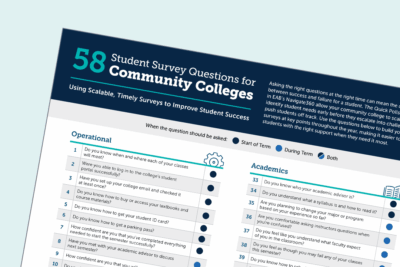Community colleges across the country are experiencing declining enrollments, from 20% reductions in New York to 25% in Oregon1. Further, more than one in ten community college presidents are concerned that their college may merge or close in the next five years2. Clearly solutions are needed to succeed within this troubling future. To help get a handle on this tough enrollment situation, many colleges are turning to strategic enrollment management (SEM), as it offers a straightforward way to prioritize efforts for a successful fiscal future.
SEM is traditionally a tool used by four-year institutions to prioritize marketing and recruitment efforts. As open-access institutions, community colleges haven’t spent time here, instead focusing their energies on serving the students who showed up on the first day of class. However, shifting demographic and economic trends, funding decreases, and state mandates have dramatically changed the enrollment landscape, such that many colleges are facing an uncertain future. The bottom line is that in order to maintain financial viability, community colleges must evaluate external and future forces impacting enrollment, then prioritize resources for the efforts that make the biggest difference.
This resource is part of the Craft a Future-Oriented Strategic Enrollment Management Plan Roadmap. Access the Roadmap for stepwise guidance with additional tools and research.
What community college SEM plans get wrong now
1 in 10

Current SEM plans try to do too much, but don’t achieve the right results. Often, they take so much time to create that they’re obsolete by the time it comes to implement.
Four problems we’ve discovered with typical community college SEM plans:
- They comprise an unrealistic laundry list of all the hopes, goals, and initiatives that the college would like to accomplish
- They contain goals that are tied to past trends and inadequately account for external forces or future outlooks
- They lack the specificity and ownership required to fulfill enrollment objectives
- They don’t account for resource availability and thus fail to prioritize
Today’s community colleges must make tradeoffs and prioritize resources for the most impactful strategies. Leaders must develop a strategic vision from available market analyses and demographic predictions to develop a transformational strategy that ensures the institution’s long-term sustainability.
Here are three things community college leaders must do to create effective SEM plans:
Economists expect the higher ed landscape will change dramatically over the next five to ten years. In order for community colleges to remain solvent, they have to be aware of and strategize specifically for these changes.
As the enrollment environment becomes more competitive, enrollment efforts must become more targeted. To succeed in this climate, assess potential market segments to inform resource prioritization.
A one-size fits all plan has failed to create change or adequately serve students. Colleges must have a more targeted approach that incorporates trade-offs and prioritization around the students they recruit and the messages they send into the market.
1 “Headcount Enrollment by Student Level and Student Load, State University of New York: Beginning 1948,” SUNY System Administration, and Office of Institutional Research, June 10, 2019.; “Community College Student Data,” Higher Education Coordinating Commission, Accessed September 10, 2019.
2 Doug Lederman, “The Mood Brightens: A Survey of Presidents,” Inside Higher Ed, March 8, 2019.
Keep learning about strategic enrollment planning
Strategic Enrollment Management Plan Framework
Meet enrollment goals by crafting strategies and prioritizing resources through a comprehensive, future-oriented strategic enrollment management (SEM) plan. Based off EAB’s extensive SEM research, this template guides college leaders through the most critical planning steps.
Here's how to start an effective strategic enrollment management plan
As many community colleges find themselves in a precarious enrollment position, leaders have recognized the importance of strategic enrollment management (SEM) planning as a tool to effectively recruit and retain a shrinking pool of prospective students. Through our research, we’ve identified the first imperative to strategic enrollment planning: Analyze the forces shaping the enrollment landscape.


